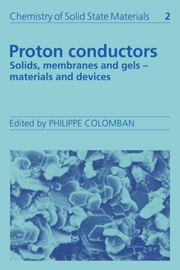Book contents
- Frontmatter
- Contents
- List of contributors
- Preface
- Symbols
- I HYDROGEN BOND AND PROTONIC SPECIES
- II MATERIALS: PREPARATION, STRUCTURES AND PROPERTIES
- 7 Structure and characterization of hydrogen insertion compounds of metal oxides
- 8 High temperature proton conductors based on perovskite-type oxides
- 9 Highly ionic hydroxides: unexpected proton conductivity in Mg(OH)2 and homologues
- 10 Ice
- 11 Anhydrous materials: oxonium perchlorate, acid phosphates, arsenates, sulphates and selenates
- 12 Hydrogen behaviour in graphite–nitric acid intercalation compounds
- 13 Proton-containing β- and β″-alumina structure type compounds
- 14 Proton conduction in zeolites
- 15 Proton containing NASICON phases
- 16 Phosphates and phosphonates of tetravalent metals as protonic conductors
- 17 Hydrogen uranyl phosphate, H3OUO4PO4. 3H2O (HUP), and related materials
- 18 From crystalline to amorphous (particle) hydrates: inorganic polymers, glasses, clays, gels and porous media
- 19 Perfluorinated membranes
- 20 Mixed inorganic-organic systems: the acid/polymer blends
- III PROTON DYNAMICS AND CHARGE TRANSPORT
- IV PROTON DIFFUSION MECHANISMS
- V DEVICES
- Index
13 - Proton-containing β- and β″-alumina structure type compounds
Published online by Cambridge University Press: 04 May 2010
- Frontmatter
- Contents
- List of contributors
- Preface
- Symbols
- I HYDROGEN BOND AND PROTONIC SPECIES
- II MATERIALS: PREPARATION, STRUCTURES AND PROPERTIES
- 7 Structure and characterization of hydrogen insertion compounds of metal oxides
- 8 High temperature proton conductors based on perovskite-type oxides
- 9 Highly ionic hydroxides: unexpected proton conductivity in Mg(OH)2 and homologues
- 10 Ice
- 11 Anhydrous materials: oxonium perchlorate, acid phosphates, arsenates, sulphates and selenates
- 12 Hydrogen behaviour in graphite–nitric acid intercalation compounds
- 13 Proton-containing β- and β″-alumina structure type compounds
- 14 Proton conduction in zeolites
- 15 Proton containing NASICON phases
- 16 Phosphates and phosphonates of tetravalent metals as protonic conductors
- 17 Hydrogen uranyl phosphate, H3OUO4PO4. 3H2O (HUP), and related materials
- 18 From crystalline to amorphous (particle) hydrates: inorganic polymers, glasses, clays, gels and porous media
- 19 Perfluorinated membranes
- 20 Mixed inorganic-organic systems: the acid/polymer blends
- III PROTON DYNAMICS AND CHARGE TRANSPORT
- IV PROTON DIFFUSION MECHANISMS
- V DEVICES
- Index
Summary
The title compounds have received a considerable amount of attention because of their high protonic conductivities at 100–300 °C. However, because of their complex characters there remain many areas of uncertainty. The current status is reviewed here.
Synthesis
It is well known that the β- and β″-aluminas are sodium ion conductors with promising applications as an electrolyte for the sodium–sulphur secondary battery. They have been widely studied because of their technological and scientific interest.
The sodium ions in the conduction planes of β- and β″-alumina type structures are exchangeable with many other monovalent and divalent cations. The main host crystals are β- and β″-alumina, and the Ga, Fe analogues: β- and β″-gallate, β- and β″-ferrite. The guest ions which contain protons include H+, H3O+ (in this review the use of H3O+ does not necessarily mean a hydronium ion), and NH4+. Many combinations of host crystals and guest ions have been prepared; details are given in Table 13.1.
The crystals, even of β-alumina, are attacked corrosively by hot sulphuric acid. Furthermore, crystals are inclined to cleave during ion exchange because the ionic radii of NH4+ and H3O+ are much larger than that of Na+14. These factors have serious implications for the fabrication of high density, polycrystalline, flaw-free ceramics (see Chapter 33).
- Type
- Chapter
- Information
- Proton ConductorsSolids, Membranes and Gels - Materials and Devices, pp. 190 - 209Publisher: Cambridge University PressPrint publication year: 1992
- 3
- Cited by



